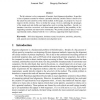Free Online Productivity Tools
i2Speak
i2Symbol
i2OCR
iTex2Img
iWeb2Print
iWeb2Shot
i2Type
iPdf2Split
iPdf2Merge
i2Bopomofo
i2Arabic
i2Style
i2Image
i2PDF
iLatex2Rtf
Sci2ools
89
Voted
BMCBI
2004
2004
Improved hit criteria for DNA local alignment
The hit criterion is a key component of heuristic local alignment algorithms. It specifies a class of patterns assumed to witness a potential similarity, and this choice is decisive for the selectivity and sensitivity of the whole method. In this paper, we propose two ways to improve the hit criterion. First, we define the group criterion combining the advantages of the single-seed and double-seed approaches used in existing algorithms. Second, we introduce transition-constrained seeds that extend spaced seeds by the possibility of distinguishing transition and transversion mismatches. We provide analytical data as well as experimental results, obtained with the YASS software, supporting both improvements.
Related Content
| Added | 16 Dec 2010 |
| Updated | 16 Dec 2010 |
| Type | Journal |
| Year | 2004 |
| Where | BMCBI |
| Authors | Laurent Noé, Gregory Kucherov |
Comments (0)

